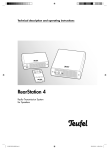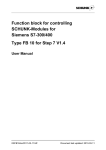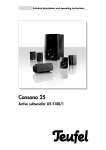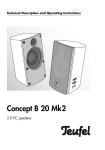Download Installation systems EKL/EMK for Vessels and Surfaces
Transcript
Installation systems EKL/EMK for Vessels and Surfaces Installation and Operation Introduction This BARTEC instruction manual for installation and operation is intended to give you important information on electric trace heating systems for pipes. Reference is made here only to the use of BARTEC EKL/EMK single-core heating cables. The contents of this manual are intended mainly for persons who are familiar with the planning, installation, operation and maintenance of electric trace heating systems. Reservation Technical data are subject to change without notice. Changes, errors and printer’s errors do not justify claims for damages. For safety components and systems the relevant standards and regulations are to be observed, as well as the corresponding operating and installation instructions. Installation and Operation Content 1. Introduction 2 2. Important Instructions 2 3. Selection of Heating Cable and configuration 3 4. Storage 3 5. Installation 5.1 Installation preparations 5.2 Installation of the heating cable 4-9 4 5-8 5.3 Installation of accessories 10 5.4 Acceptance and inspection 11 Acceptance certificate 12 6. Temperature Control 13 7. Temperature Limiter 14 8. Heat Insulation 15 9. Power Supply and Electrical Protection Devices 16 10. Inspection and Commissioning 17 11. Operation and Maintenance 18 - 20 12. Proceeding in Fault Cases 20 - 22 12.1 Circuit-breaker trips 21 12.2 Residual current operated circuit-breaker trips 22 12.3 No or insufficient heating capacity 22 12.4 Heating capacity seems to be correct, the pipe temperature, however, does not reach the desired temperature 22 1 Installation and Operation 1. Introduction The present BARTEC manual for installation + maintenance is to provide you with important information on electrical trace heatings for vessels and surfaces. It exclusively applies to the use of ■ BARTEC-EKL (flexible single-core heating cables) as well as ■ BARTEC-EMK (single-core mineral-insulated heating cables). The content of this manual is particularly directed towards persons who are entrusted with the planning, erection, operation and maintenance of electrical trace heatings. This manual applies to the following BARTEC products: ■ BARTEC EKL heating cables type: 27-582.-5512-.... ■ BARTEC EKL light heating cables type: 27-582.-5514-.... ■ BARTEC EKL EX heating cables type: 27-582.-5518-.... ■ BARTEC EKL standard connection kits type: 27-5673-.1.. ■ BARTEC EKL EX termination kits type: 27-5671-.2.. ■ BARTEC EMK heating cables type: 27-383.-20../.... ■ Pre-assembled EMK heating circuits EX/Standard Pre-assembled EMK heating loops EX/Standard type: 27-361.-.... ■ Installation accessories The BARTEC warranty only applies if all provisions and recommendations of the manual and the product-accompanying installation and mounting instructions are strictly adhered to. This particularly applies to the above-mentioned instructions. 2. Important Installation and Maintenance Instructions Observance of the following instructions is imperative when installing and maintaining BARTEC-EKL and BARTEC-EMK heating cables and their respective installation systems. Non-observance of these instructions may imply serious hazards for both personnel and system components. For the installation and maintenance of electrical trace heatings, the respective applicable EC standards and directives, the national regulations as well as the respectively valid safety regulations must be complied with. Examples of applicable standards and directives: DIN VDE 100; EN 50110 (1+2); VBG A2; EN 60519. Please particularly observe the respective applicable EC standards and directives, the national regulations as well as the respectively valid safety regulations for the application of electrical trace heatings in hazardous areas. Examples of the valid standards and directives for the application of electrical trace heatings in hazardous areas: EN 60079-14; 94/9/EC Directive; 1999/92/EC Directive; BetrSichV (German occupational safety regulations). ■ Improper installation of the trace heating and the adjacent system components or heating cable damage may bear the risk of short circuits and fire during operation. ■ When using an EKL or EMK heating cable in hazardous areas, a temperature monitor as well as a temperature limiter must always be applied, given no deviating provisions were specified during the dimensioning and selection of the system. ■ Protect both ends of the single-core heating cable against environmental impact. ■ Junctions or contact points of the single-core heating cables are impermissible as the limit temperature of the temperature class or the max. permissible operating temperature of the heating cable would be exceeded. ■ To ensure a proper installation of BARTEC single-core heating cables, we recommend the use of BARTEC connection systems. Such systems have been specifically developed for BARTEC heating cables and have been tested and approved by test institutes. 2 Installation and Operation 3. Selection of the Heating Cable and Configuration Prior to any installation of electrical trace heatings, the installer must check whether the trace heating has been properly configured. Particularly, the following aspects must be verified: ■ Is an accurate configuration documentation and operation manual available? ■ Does the selected heating cable meet the respective requirements? This particularly refers to: - calculated heat loss - temperature class specified in the type examination certificates - max. permissible operating temperature - max. permissible ambient temperature ■ Does the used pipe length exceed or underrun the calculated length? ■ Has a connection system been selected which complies with the requirements? ■ Does further material, which belongs to the trace heating or the adjacent installation, meet the - electrical - mechanical - thermal - chemical requirements? ■ Has electrical equipment been selected for installation in hazardous areas for which an EC type examination certificate or a conformity certificate is available? If a respective configuration documentation is not provided for, we recommend a verification of the above-mentioned points on the basis of the BARTEC product documentation. Should any questions arise during the examination of configuration documents, we recommend you to contact the BARTEC technical department. Thanks to their comprehensive system know-how and a DPsupported configuration, our expert team will provide you with assistance. For the address of our technical department, please refer to Chapter 12. 4. Storage Incoming goods ■ Compare the delivery note with the supplied goods. ■ Examine the supplied heating cables and accessory components for possible transport damage. Storage ■ Store heating cables and connection components at a clean and dry location. ■ During storage, particularly contact with chemicals and petrochemical products must be effectively avoided. ■ It must be ensured that the heating cables are protected against mechanical damage during storage. ■ The storage temperature is specified in the respective data sheets and must be observed. ■ Even if heating cables and connection components are only shortly stored in damp rooms or at a construction site, the ends must be effectively protected against humidity (e.g. by installing an end termination). 3 Installation and Operation 5. Installation 5.1 Installation preparations 5.1.1 Scheduling ■ The installation of the electrical trace heating must be temporally coordinated with other installation works. This particularly refers to works carried out at the vessels and surfaces to be heated, the electrical installation and heat insulation. ■ All installation works at the vessels and surfaces must have been completed. ■ Pressure tests as well as material tests of the piping system should have been terminated prior to installing the electrical trace heating. 5.1.2 Inspections prior to installation ■ Measure the installation resistance at the heating cable shortly before starting the installation works. ■ Check on the basis of the insulation resistance measuring whether the supplied heating cable length corresponds to the configuration specifications. ■ Check whether all material required for the installation of the electrical trace heating is available at the construction site and free of damage. ■ Above all, check whether the identification of the heating cable and the components complies with the configuration documents (material list) and type examination certificates. ■ Check on the basis of the product-accompanying installation instructions whether all required tools are completely available. ■ Plan the routing of the heating cable by inspecting the vessel/surface to be heated. ■ Within this context, pay attention to sharp edges and uneven surfaces which may damage the heating cable and remove them. ■ Varnished and painted vessels and surfaces must be completely dry before starting installation works. ■ Verify whether the actual surface to be heated complies with the calculated surface. ■ Prior to routing the heating cable, verify whether the vessel/surface dimensions comply with the dimensions used for design dimensioning. Only cut the heating cable to length after it has been routed and fixed in accordance with the design dimensioning. 4 Installation and Operation 5.2 Installation of the heating cable 5.2.1 Routing of the heating cable - installation of the fixing accessories (spacing strip/wire mats) ■ Approx. 25 fixing pins per square meter must be attached to the surface to be heated by means of spot welding. ■ The points for the welding spots on the surface to be heated must be cleaned by means of an angle grinder or a similar device (sketch 1). ■ Then, the fixing pins are welded to the surface by means of spot welding (sketch 2). ■ Following this, the welding points and the blank surfaces must be varnished with a corrosion protection paint. After the coating has dried, the fixing strip can be installed. Cleaned surface Fixing pins Sketch 2 Sketch 1 5.2.2 Installation of the spacing strips ■ The spacing strips (EKL/EMK - sketch 3a) must be attached to the vessel/surface by means of the spring washers in accordance with the spacings specified in the configuration (sketch 3b). Alternatively, the spacing strips can be welded to the vessel/surface. When installing the spacing strips, attention must be paid to sharp edges – risk of injury! EKL spacing strip EMK spacing strip Sketch 3a Sketch 3b 5 Installation and Operation 5.2.3 Installation of the wire mats ■ The wire mats must be cut to correspond with the respective shape of the surfaces to be heated. These mats are then fixed with a sufficient number of spring washers (sketch 4a-4c). When installing the wire mats, attention must be paid to sharp edges - risk of injury! If required, sharp edges of cutouts must be bent to the inside. Sketch 4a Sketch 4b Sketch 4c 6 Installation and Operation 5.2.2 Installation of the heating cable ■ To unroll the heating cable, use a stable fixture for the heating cable reel. ■ Evenly wind the heating cable off the reel (sketch 5). Avoid extensive pulling as well as bending and crimping of the heating cable. ■ When rolling the heating cable off the reel, observe that the cable does not run over corners or sharp edges. ■ Do not step on the heating cable! Do not use the heating conductor as a stepping loop! Do not drive over the heating cable with a vehicle and keep other people from driving over the cable. correct wrong Sketch 5 EMK heating cable ■ Starting at the terminal box, the heating cable is routed over the surface to be heated in loops and fixed by means of the EMK or EKL spacing strip attached beforehand (sketch 5). With the EMK spacing strip, the heating cable is routed beneath pre-punched lugs which are then bent or tilted over the heating cable. With the EKL, the heating cable is installed in the provided terminals (sketch 6). Prior to routing the heating cable, the spacing strips are fixed to the surface to be heated by means of fixing pins and locking washers attached beforehand or by means of welding. For this purpose, the surface is punctually cleaned in accordance with the partitioning to prepare the fixing pins’ welding by means of the weld clamp (refer to 5.2.1; 5.2.2). Or fixed to the vessel/surface by means of wire mats installed beforehand. The EKL/EMK heating cables are fixed to the wire mats by means of binding wire which is twisted together with the help of combination pliers or a different tool. When using EKL heating cables, also cable ties can be used for heating cable fixation. It must, however, be observed that the cable binder/binding wire must not be excessively tightened. The heating cable must still be able to move in the loop of the cable binder/binding wire (sketch 7). ■ When routing the heating cable, always observe the minimally permissible bending radius! (5 x external diameter for EKL and EMK). Example: ED heating cable Cable spacing Cable spacing = 3 mm = Factor bending radius x external diameter heating cable = 5 x 6 mm = 30 mm ■ When routing the heating cable, observe that the heating cable can be re-routed without any junctions. ■ When routing, consider all fixtures and extensions of vessels and surfaces. ■ Both with the EKL as well as with the EMK, the heating cable terminations consist of transition sleeves and a connected cold cable. For electrical connection, the ends of the cold cables are inserted in the terminal box and connected in accordance with the terminal plan. ■ If required by the project, the entire heated surface is covered with aluminium foil after completion of the installation works (sketch 8). 7 Installation and Operation Heating cable installation with spacing strip EKL spacing strip Sketch 5 EMK spacing strip Sketch 6 Heating cable installation with wire mats Sketch 7 Heating cable coverage with aluminium foil Sketch 8 8 Installation and Operation Fixing material selection chart Max. temperature Width Roll length Aluminium self-adhesive tape/EKL 150°C 50 mm 55 m 02-5500-0014 Aluminium foil 400°C 1m 100 m 02-2430-0002 Aluminium foil 400°C 1m 10 m 02-2430-0003 Polyester clamping ring for heating cable fixation (EKL) 105°C 16 mm 1m 03-6500-0100 1 item 03-6515-0203 Self-adhesive tape for heating cable type Turnbuckle for polyester clamping ring (EKL) Order no. Material Width/Length P S/S clamping ring EMK Stainless steel 3/8'' 3/4'' 30 m 30 m 03-6510-0203 03-6510-0204 S/S clips clamping ring Stainless steel 3/8'' 3/4'' 100 items 100 items 03-6515-0201 03-6515-0202 EKL spacing strip Stainless steel 10 mm 1m 03-6510-0200 EMK spacing strip Stainless steel 12.8 x 0.75 mm 30 m 03-6510-0201 Welding pins Stainless steel Galvanized CU 1000 items 1000 items 03-5470-0002 03-5470-0001 Spring washers Stainless steel Galvanized CU 1000 items 1000 items 03-5479-0001 03-5479-0002 Wire mats Stainless steel Galvanized steel 25 m2 25 m2 02-2210-0003 03-5479-0002 Accessories 1m 1m When selecting the self-adhesive tapes and spacing strips, observe the maximum surface temperature of the heating cable. Mineral-insulated heating cables are generally fixed by means of stainless steel clamping rings. 9 Installation and Operation 5.3 Installation of accessories ■ Only use BARTEC original accessories to comply with existing technical regulations and approvals. ■ Please observe that the use of BARTEC original accessories constitutes a condition for possible warranty claims. ■ Carefully observe the installation instructions and technical notes on the package inserts of the respective accessories. This is imperative for a fault-free installation. 5.3.1 BARTEC system accessories Beside the heating cable, the following system accessories are usually required for the complete installation of a heating circuit: ■ Heating cable connection system ■ Cold leads ■ Fixing accessories for the heating cable ■ Heat-insulation ducts ■ Warning labels “electrically heated” Further system accessories may be additionally required: ■ Heating cable connection ■ Terminal box/connection box ■ Mounting bracket and mounting plate for terminal or connection box ■ BARTEC control units 5.3.2 Further installation instructions ■ Prior to installing the power supply lines, install the heating cable connections. ■ Install terminal boxes in a freely accessible way. ■ When positioning the terminal boxes, make sure that the box entries with cable and heating cable screw connections do not point upwards. ■ When installing connections, ensure the existing cable paths can be further used. ■ During installation, keep the terminal boxes closed as long as possible to provide protection against dirt and humidity. ■ Check for a proper establishment of the termination system and the correct functioning of the heating circuit by measuring the insulation and the loop resistance (Chapter 9). After the installation of boxes, check: whether suitable and approved screw connections and filler plugs have been used and whether they have been properly installed. for a tight fit of screw connections and filler plugs. for a tight fit of the box at the mounting bracket. Ensure whether the requirements stipulated in the type examination certificates have been met. 10 Installation and Operation 5.4 Acceptance and inspection Caution Prior to fitting the heat insulation, the installed heating circuits must be inspected. Inspection process ■ Prior to the correct routing of the heating cable, particularly observe that the heating cable fits tightly with the vessel/surface the heating cable does not show any contact points or junctions the heating cable does not show any damage ■ Check for a proper installation of terminals, connections and terminal boxes as well as temperature controllers and sensors (visual check). ■ Check for a proper installation of the limiter sensor (mandatory for heating circuits in hazardous areas), as well as for the limiter setting. ■ Enter the position of the heating cable as well as that of terminals and connections into the piping documentation. ■ Measure the insulation resistance in all heating circuits before installing the heat insulations (Chapter 9). ■ The correct installation and functioning of the electrical trace heating must be confirmed by means of an acceptance certificate (refer to the following sample form). ■ With stabilised design, verify the conditions stipulated in the project documentation for compliance. 11 Acceptance Certificate and Operation Installation Electrical trace heatings Sheet Vessel heatings Heating circuit Customer Date Order Comm. No. Project system BARTEC order No. Serial No. Heating circuit No. Pipe/vessel No. Building Product Heating cable Type Installation number Heating cable length m m m Voltage V V V Switch-on A A A Operation A A A W/m W/m W/m Cold Ω Ω Ω Hot Ω Ω Ω Current Capacity Resistance Insulation resistance- Setpoint: ≥ 5 MΩ with 1000 V measured voltage > Temperature setting Function check MΩ yes MΩ > Function check no yes MΩ > Function check no yes Controller °C °C °C Limiter °C °C °C Low temperature °C °C °C EX version Ex Ex Ex T T T Temperature class no Comments: Above entries verified: City/Date BARTEC GmbH 12 Installer Max-Eyth-Straße 16 D-97980 Bad Mergentheim Customer Phone: +49(0)7931 597-0 Fax: +49(0)7931 597-119 Installation and Operation 6. Temperature Control Selection of a temperature controller ■ For operations with single-core heating cable systems, a temperature controller is always required. ■ When selecting a suitable temperature controller, particularly the following technical data must comply with the requirements of the respective application: Rated voltage Rated current Temperature control range Max. permissible temperature/max. permissible sensor temperature IP protection Explosion protection, if required Type examination certificate ■ For reasons of an economical power utilisation, the use of a controller with surface sensor is in all cases recommendable. ■ Prior to installation, verify whether the applied temperature controller complies with the technical requirements and the configuration. Room temperature controller ■ Install a room temperature controller always at the coolest spot of the environment (e.g. north side). ■ Observe the installation instructions of the respective room temperature controller. Temperature controller with sensing line ■ With surface heatings, the temperature sensor should not be positioned directly at the heating cable (sketch 9). ■ When fixing the temperature sensor, a sound heat transmission between the sensor and the surface must be ensured (e.g. by using an aluminium self-adhesive tape or heat transfer compound). ■ Observe the installation instructions of the respective temperature controller. ■ If the position of the temperature controller should not be defined by configuration, please contact the technical department of BARTEC (Chapter 12), where you will get expert advise. Further installation instructions ■ During installation, keep the casing of temperature controllers closed as long as possible to prevent dirt and humidity from intruding. ■ Ensure for a proper fixing of the casing cover and a close sealing. ■ Use suitable screw connections and filler plugs in accordance with the technical requirements and type examination certificates and check for their impermeability. 13 Installation and Operation 7. Temperature Limiter For all single-core heating cable systems of monitored design (EKL or EMK), a temperature limiter must be used in hazardous areas. A limiter permanently switches off the heating circuit upon exceedance of the limit temperature. The temperature limiter must be installed at the hottest spot. Maximum surface temperature Temperature class 450°C T1 300°C T2 200°C T3 135°C T4 100°C T5 85°C T6 The temperature limiter’s task is to avoid an exceedance of the limit temperature in the tracer heating system, e.g. in case of controller failures or overvoltage, by switching off the heating. Within this context, the selection and installation of the temperature sensor plays a particularly important role. As regards the measuring accuracy, the selected sensor mass should be as low as possible. As a matter of fact, the hottest spot in the system is supposedly at the heating cable itself - usually at locations where a sound thermal connection of the heating cable to the surface to be heated is hardly possible, e.g. at valves or flanges. Artificial hot spot An artificial hot spot is created by fitting a heat insulation between the heating cable and the surface to be heated, at which the sensor for the temperature limiter is installed with direct contact to the heating cable (sketch 9). ■ When installing the temperature limiter, observe that the sensor is positioned at the hottest system spot. Use aluminium to fix the sensor and the heating cable to each other. To ensure that the temperature at the artificial hot spot is definitely higher than the heating cable temperature at spots with minor thermal connection, this hot spot must be dimensioned with approx. double sensor length. ■ As a result of the unavoidable heat dissipation of the sensor itself, the deviation from the sensor mass depends on the heating cable mass (proportion of diameters) as well as on the specific heating capacity (W/m) and must be considered when setting the limiter temperature. ■ Each EKL/EMK heating circuit in hazardous areas must be equipped with a limiter. ■ When using an adjustable temperature limiter, the switch-off point must be set at up to T3 min. 5K and T2 and T1 min. 10K [refer to EN 50019;28] below the maximum surface temperature of the temperature class. Example: For T3, limiter setting 195 °C. 14 Installation and Operation Temperature sensor Artificial hot spot Limiter sensor Sketch 9 8. Heat Insulation Important instruction Prior to fitting the heat insulation, verify whether an acceptance inspection of the insulation has been carried out and documented. Installation of the heat insulation The reliable functioning and efficiency of an electrical trace heating essentially depends on a proper and professional heat insulation installation. The following factors must be particularly observed: ■ Check for the compliance of the heat insulation (type, insulation thickness) with the configuration. A heat insulation deviating from the configuration must, in no case, be installed as otherwise a correct functioning of the trace heating can no longer be guaranteed. This must be particularly observed for heating systems of “stabilised design”. ■ Install the heat insulation immediately after the installation of the trace heating to minimise the risk of heating cable damage. ■ Only use dry insulation material. Humidity reduces the efficiency of insulation material and thus impairs the function of the trace heating. ■ When installing the heat insulation, always take care not to damage the heating cable. ■ Only use BARTEC heat insulation ducts for the ducting of heating and connection cables. ■ Seal the heat insulation at all welds of the steel jacket and entries (valve entries, suspenders). The entire insulation must be reliably water-proof. ■ After installation of the heat insulation, measure the insulation resistance at all heating circuits once more to ensure that the heating cable has not been damaged during the installation. Marking ■ Mark the outer sheath of the heat insulation with “electrically heated” warning labels in clearances of maximally 3 meters in order to draw the attention of maintenance personnel to the electrical trace heating. 15 Installation and Operation 9. Power Supply and Electrical Protection Devices Rated voltage ■ BARTEC heating cables are available for various rated voltages. Respective information is available in the BARTEC catalogue and from the technical department of BARTEC. ■ Operate the respective heating cable only with the rated voltage provided for. The rated voltage is stated on the computer print-out of the heating cable layout. Overcurrent protection device ■ For overcurrent protection, please only use circuit-breakers which comply with the configuration and the technical BARTEC documents. Deviations therefrom may result in false tripping of the circuit-breaker and impairment of the efficiency of the overcurrent protection. ■ If protection units other than those specified in the configuration or the technical BARTEC documents are to be used, please contact the technical department of BARTEC (Chapter 12).. Residual current operated circuit-breaker ■ Principally, the use of a residual current operated circuit-breaker with 30 mA is recommended. ■ To ensure for the efficiency of this protection measure, a heating cable with protective braiding is to be used. This protective braiding must be incorporated into the protection measures. this particularly applies to all trace heatings connected to non-conducting pipes (plastic pipes, coated pipes) and surfaces. Caution ■ When implementing the electrical protection measures, the respectively applicable national technical regulations must be adhered to. In the Federal Republic of Germany: VDE regulations, particularly DIN VDE 0100, DIN VDE 0254 and EN 60519. 16 Installation and Operation 10. Inspection and Commissioning Inspections Continuing inspections of the trace heating during installation and operation serve the prevention of additional costs accruing from a belated detection of installation and mounting faults. As the installation costs for the trace heating and the heat insulation exceed the costs for the heating cable by far, the following inspection procedures should be consistently followed. The insulation resistance is to be measured at the following points of time: a) Pre-inspection Shortly before commencing installation of the heating cable at the construction site b) Acceptance inspection After the heating circuit has been completely installed or prior to applying the heat insulation c) Final inspection Immediately after the works at the heat insulation have been completed d) Commissioning inspection Prior to switching on the system Measuring of the insulation resistance ■ This inspection procedure serves the detection of heating cable damage and possible installation faults of terminals and connections. ■ An insulation test device with a minimum test voltage of 500 V DC and a maximum test voltage of 2000 V DC is to be used. The insulation resistance should be at least 50 MΩ per heating circuit, irrespective of the length. ■ Measuring: The measuring is to be carried out between the heating conductor and the protective braiding. A further measuring is to be carried out between the protective braiding and the earthed piping. Acceptance and documentation ■ Upon completion of the installation works (prior to applying the heat insulation), each heating circuit, if possible in the presence of the client, must be accepted. In accordance with the enclosed sample report, this acceptance inspection must be documented (=acceptance inspection). ■ All further inspections must also be documented in the form of an inspection report. ■ After the heat insulation has been completely installed, a final inspection of the individual heating circuits is recommendable. ■ Usually, such inspection lies in the area of responsibility of the client or the final customer (=final inspection). Commissioning ■ Each trace heating must only be commissioned if the acceptance certificates are available for each heating circuit and the fault-free condition of the trace heating has been confirmed. the heat insulation has been completely installed and is in a dry state. it is ensured that the heating circuit is operated in compliance with the data specified by BARTEC. Note Additional heating energy which is required for heating empty or already filled vessels has usually not been accounted for by the configuration. With system cold starts, you should therefore grant a sufficient period of time for the vessel to achieve the desired temperature. 17 Installation and Operation Note Electrical equipment must only be operated in hazardous areas if ■ it is subject to an EC type examination certificate issued by a testing laboratory listed in Section 14 of the 76/117/EEC directive and ■ It has been marked with the symbol by the manufacturer. ■ it complies with the respectively applicable EC standards and directives, the national regulations as well as with the respectively applicable safety regulations. Example: German occupational safety regulations (BetrSichV), EN 50014, EN 50019 11. Operation and Maintenance Operation ■ During the operation of the electrical trace heating, it must be ensured that all system components are operated in compliance with the operating data specified by BARTEC. This particularly applies to the observance of maximum temperatures. Operation within the range of these operating data forms a condition for possible future warranty claims. System documentation ■ For each system, a complete documentation ranging from configuration, to installation and commissioning to periodical maintenance works of a trace heating, should be kept. ■ Such documents should include: Configuration documents Heat loss calculation Selection of the heating cable System plans with heating circuit allocation Circuit diagrams Acceptance certificates Reports on servicing works and interventions with vessels and surfaces, the trace heating and the heat insulation Inspection reports Operating manual Maintenance To allow for the best possible safety and reliability of a trace heating system, BARTEC recommends the implementation of a maintenance program which provides for visual, functional and electrical checks within specified time intervals. Important maintenance instructions are listed in the following sections. 18 Installation and Operation Visual and functional check ■ Carefully check the heat insulation for possible damage, lacking sealings, cracks, outer sheath damage, lacking heat insulation ducts for heating cables and other cables, intruded water or chemicals. If the heat insulation is subject to damage, the heating cable must be checked for possible impairments. Damaged heating cables must be replaced by new ones. Wear parts (e.g. sealings, locking plates, etc.) must be replaced. ■ Check the terminal boxes, connection boxes and casings of temperature controllers for corrosion damage and possible mechanical impairments. Make sure that all casing covers are correctly locked. ■ Check the temperature controller’s/safety temperature limiter’s connecting cables and capillary tube systems for damage and mechanically protected routing. ■ Temperature controllers must be checked for their correct functioning. ■ If no safety temperature limiters with permanently adjusted switch-off value are applied, they must also be checked for their correct functioning. Electrical inspection ■ The measuring of the insulation resistance should be considered as an inherent part of the regular maintenance works. Inspection intervals ■ With anti-freeze systems, inspections should be carried out annually before the heating period. ■ With systems serving the maintenance of process temperatures, inspections should be carried out in regular intervals, however, at least twice a year. Personnel training ■ The regular maintenance works should be carried out by trained and experienced maintenance personnel. ■ You are recommended to support maintenance personnel with the implementation of new developments in the fields of application technology and maintenance by training measures. BARTEC service ■ Apart from establishing complete heating circuits, BARTEC also offers its experienced service personnel for accruing maintenance works. Servicing works at the heat insulation and pipings ■ Observe that the system is to be activated prior to each servicing procedure. ■ Ensure not to damage the trace heating system during servicing works at the vessel or the heat insulation. ■ Make sure that, upon completion of servicing works, the heating circuits, including heat insulation, are properly and professionally installed in accordance with the configuration. ■ Upon completion of servicing works, carry out a visual, functional and electrical check at the trace heating and document such checks. Note The operation and, consequently, the maintenance of explosion-protected operating equipment and systems are subject to the respectively applicable EC standards and directives, the national regulations as well as the respectively valid safety regulations. For example: EN 50110; German occupational safety regulations (BetrSichV); German law on device safety (GSGV) In Germany, the operator must assure that the electrical systems are commissioned, inspected and maintained in accordance with the German occupational safety regulations (BetrSichV). 19 Installation and Operation 12. Proceeding in Fault Cases Damage in the heating circuit ■ Never try to repair any damaged heating cables! Immediately replace the damaged part of the heating cable by a new one (risk of fire!). ■ For servicing the heating circuit, only use original BARTEC components! (e.g. connections, terminals, sealings, etc.) Instructions for the rectification of faults ■ If faults occur in the trace heating system, we recommend troubleshooting in accordance with the following instructions and, if applicable, rectification of the fault. ■ If the rectification measure in accordance with the following instructions is not successful, please immediately contact the technical department of BARTEC. Note For hazardous areas, the following provisions are applicable Servicing and modification works at electrical systems, during which an explosive atmosphere can be ignited, may only be carried out with the approval of the plant manager or a respectively authorised person. The most important safety measure is to create and ensure for a voltage-free condition prior to commencing works (refer to the respectively applicable standards and regulations). An authorization for the execution of hot works is required and, when working with hot surfaces/flames, respective protection measures must be taken. 20 Installation and Operation 12.1 Circuit-breaker trips Possible cause Measures 1. Underdimensioned circuit-breaker Check the current load, the overcurrent protection fuse and the max. current carrying capacity of the electrical supply line 2. Excessive heating circuit length 3. Switch-on at too low temperatures (observe configuration data) 4. Faulty RCCB Replace the RCCB 5. Short-circuit/ground fault at - terminal - connection(s) - connection lines - heating cable due to damage Localize and repair faulty terminal or connection or localize and replace the faulty heating cable 12.2 Residual current operated circuit-breaker (RCCB) trips Possible cause Measures 1. Underdimensioned circuit-breaker Check the current load, the overcurrent protection fuse and the max. current carrying capacity of the electrical supply line 2. Faulty RCCB 3. Short-circuit/ground fault at - terminal - connection(s) - connection lines - heating cable due to damage 4. Excessive humidity in terminal or connection(s) due to improper and unprofessional installation Localize damp spot(s), replace the terminal block and dismount affected parts; first, check and repair casings outside and then casings underneath the heat insulation 5. Heating cable or connection line damage Localize the impaired spot and install a new heating cable or connection line 21 Installation and Operation 12.3 No or insufficient heating capacity Possible cause Measures 1. No or insufficient line voltage Control the line voltage at the heating circuit infeed and rectify existing faults 2. Heating circuit length is longer than specified in the configuration Check heating circuit allocation, routing and length, re-calculate required heating capacity a) Connections have not been established a) Establish connections and re-check the heating capacity b) The heating cable has been interrupted b) Localize and remove the interruption, then re-check the heating capacity 3. High transmission resistance due to an improperly installed terminal, connection Re-install the respective terminal, connection, etc. and ensure for a correct clamping and crimping 4. Temperature controller has been incorrectly connected or set or wrong sensor position Correct the wiring or position the sensor properly 5. Exceedance of the max. permissible vessel/surface temperature Check the vessel/surface temperature 6. Heating cable has been subjected to excessive humidity (e.g. faulty connection or heating cable damage) Replace faulty parts 7. Heating cable has been subjected to excessive temperatures Replace the heating cable 8. Temperature limiter has tripped Check and, if required, replace heating circuit 10.4 Heating capacity seems to be correct, the pipe temperature, however, does not reach the desired temperature 22 Possible cause Measures 1. Damp heat insulation Replace the damp heat insulation by a dry one and ensure for a correct sealing 2. Insufficient fit of the heating cable routing with flanges, valves and controls and instruments Use an additional heating cable by means of connections while not exceeding the max. permissible heating circuit length 3. Incorrect setting of the temperature controller Correct the controller setting 4. Insufficient thermal dimensioning Check the dimensioning in co-operation with the technical department of BARTEC and observe the recommendations of the BARTEC planning department 5. The connection line cross-section underruns the permissible value (excessive voltage drop) Use a connection line with a permissible cross-section 6. Wrong sensor position Position the sensor correctly BARTEC protects people and the environment by the safety of components, s y s t e m s BARTEC GmbH Max-Eyth-Straße 16 D-97980 Bad Mergentheim Phone: +49 7931 597-0 Fax: +49 7931 597-494 [email protected] www.bartec.de UK-D-BEH240604-08/04-BARTEC WerbeAgentur-232188 and plants.


































